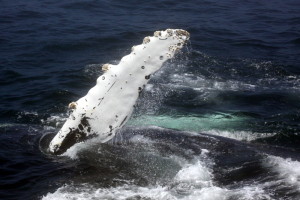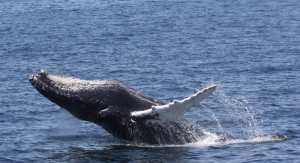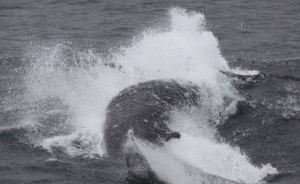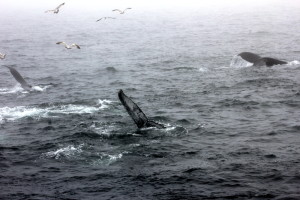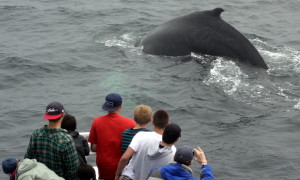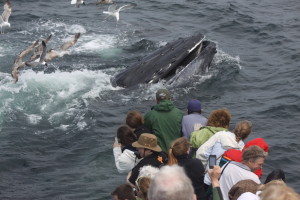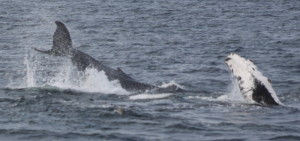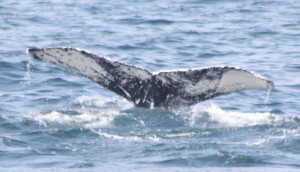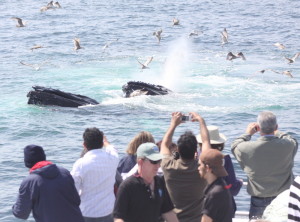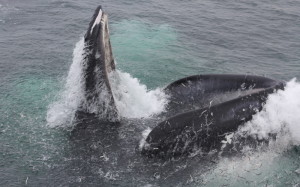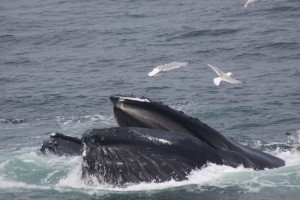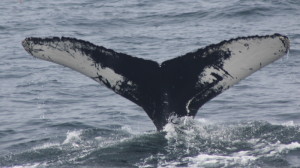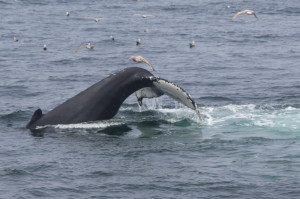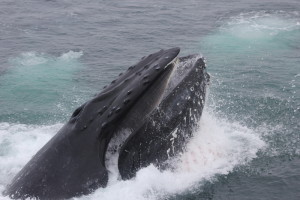Naturalist Notebook – May 24 to May 30
Despite lovely weather inshore on May 24th, we found upon our arrival that a thick layer of fog had settled over Stellwagen Bank. We went to the area where whales were seen the day before, slowed, and listened, trying to locate the whales by the sound of their breath. Then, we heard a slap. We followed the sound and found Alphorn, a 29 year-old male, slapping his pectoral flipper on the water!
Alphorn ended up being a really consistent breacher. After doing a quick dive, known as a wind-up, he would hurl himself skyward, all 40 tons of him splashing down in front of the Dolphin IX.
The skies soon cleared and we were able to look east to find humpback whale feeding groups. The feeding subsided by the time the late afternoon trip aboard the Dolphin VIII made it out there, but with clear skies, nearly flat seas, 21 humpback whales including two mother/calf pairs out there, we certainly didn’t mind!
The fog returned on May 25th, but the tranquil grey environment out on Stellwagen was soon shattered by two lunging fin whales! We’ve been lucky enough to see a lot of humpback whale feeding activity so far this season, but catching fin whales in the act of feeding is much more unusual. Fin whales use their great speed as an advantage, lunging through schools of fish at over 25 miles an hour, rolling 90 degrees to one side as they do so. In the photos below, you can see the sand eels leaping out of the way, trying to escape the jaws of this voracious finner!
More than fifteen hungry humpbacks soon followed, feeding in various, ever changing groups followed as the day went on. Huge bubble nets formed, and they encompassed at least a dozen individuals, including Centipide, Anchor and calf, Midnight, Ventissca, Mostaza, Underline, Wizard, Mystery, A-Plus, Music, and Etch-a-Sketch.
The feeding groups eventually broke up and the whales began to head east. As the visibility cleared, we could see for miles, and we noticed several splashes to the east. We did “drive-bys” to several small groups of feeding whales, including Blackhole, Eruption, Tunguska, Putter and Causeway. Even though these whales also seemed to be on the move, they would periodically stop to keep feed or blow a bubble net.
Our naturalists estimated that they saw between 47 and 60 humpbacks during the mid-day trip on the Dolphin VIII!
We started out our morning on May 26th with a look at a huge gray seal. Gray seals can be distinguished from the smaller harbor seal by its horse-like profile. Indeed, its Latin name, Halichoerus grypus has a rather unflattering translation to mean “hook-nosed sea pig”! The males are larger than the females, and our gray seals here in the Western North Atlantic dwarf their cousins to the east, sometimes reaching weights sometimes exceeding 800 pounds!
We found our humpbacks feeding again, but they seemed to be using a slightly different style of kick-feeding and feeding on something other than sand lance. We guessed that it might be some other small schooling fish like herring, and were amazed to watch them do a hybrid of a breach and a lunge to capture their prey!
Rapier’s calf was especially energetic today, imitating its kickfeeding mom by slapping the whole tail-end of its body on the surface of the water. Calves don’t fully wean until they’re about a year old, but they can sometimes be seen imitating the feeding behaviors of their mothers, preparing for the day that they will have to locate food on their own.
May 27th started with a bang! Our first two whales of the day breached at the same time. “Duellies!” the captain exclaimed, just as surprised as all of the passengers were to see two enormous humpbacks leap out of the water. simultaneously.
Our naturalist noted a new humpback for the year — Shards. Shards has a very intricate pattern on his flukes that resembles shards of broken glass.
Warm sunshine and calm seas prevailed into the afternoon, where we found a massive feeding bout on the southwest corner of Stellwagen Bank. Fracture and Pogo, two humpbacks that are regularly seen together on Stellwagen Bank, were feeding in bubble clouds.
Several Minke whales even joined the gang. While they were not directly observed feeding, a group of five, normally elusive Minkes in the presence of feeding humpbacks suggested that they had found something to munch on as well!
On May 28th, the fog seemed to be creeping in, but as we headed towards the whales, the visibility cleared and we could see for miles once we approached the southern edge of Stellwagen Bank. Wizard and Ventisca have been a pair for the past week or so. While long-term stable social associations are not typical of baleen whales as much as they are with toothed whales, we will sometimes see humpbacks pairing off for days at a time, particularly older females. These two seemed to be feeding cooperatively. Wizard was often seen kick-feeding, and we assumed that Ventisca was reaping the benefits of that harvest!
Shards, a male born in 1991, has been consistently gulp feeding and we noticed that his large lunges separate him from the rest of the feeders out there. Different feeding behaviors are sometimes indicative of different prey patches. Shards feeding behavior was so different from the other whales that we almost wondered whether he was feeding on something different, although the prey flying out of his mouth suggested that he just has his own style!
Another pair, Blackhole and Eruption, are often seen together, and we noticed that Blackhole is the consistent kickfeeder in the group. We also were able to get a good look at Pisces and her calf. They were a distance from the group, but Anchor and her calf gave us a chance to observer a mom/calf pair as they joined up with Pogo and Fracture.
By the time we returned in the evening, the feeding had become more sporadic, but fortunately, Nimbus and her calf provided us with plenty to look at. Nimbus sounded on a long dive, while her calf breached and lobtailed continuously, some distance away from where its mom was last seen. This seemingly playful behavior can sometimes be a signal from a calf to let its mom know of its whereabouts….then again, it might be just play!
May 29th was another foggy morning, but just like in previous days, it opened up by the time we got to Stellwagen Bank. We noticed more Sooty Shearwaters than we had seen in a while. These migratory seabirds flock to the Western North Atlantic every summer to feed on the same small schooling fish that the whales prey on, so their presence is both a sign of the coming summer season as well as of the abundant food source in the area.
The whales were very active this morning. Sanchal, a young humpback, initially attracted us with its display of flipper slapping. We have been watching Sanchal ever since 2008, when it arrived on Stellwagen Bank with its mother, Salt, one of the most well-documented whales on Stellwagen Bank. This flipper slapping behavior, in which is a whale slams its pectoral flippers on the surface of the water, is a common practice among humpbacks, yet the exact reason for this behavior is unknown.
Later, a small group of Atlantic white-sided dolphins joined a group of feeding humpbacks, and everyone was moving around haphazardly. Just when we thought we had left Ventisca and Etch-a-Sketch behind, they would pop up again right next to our boat with some wide open mouth lunges.
Rapier’s calf was by far the highlight of the day. This little humpback couldn’t stay in the water and was breaching over and over again. Even as we left Stellwagen Bank and headed for home, we could see this young whale breaching behind us as we made our way back to Provincetown.
May 30th broke the pattern of foggy mornings and the day was calm and clear from the get-go. Today, the whales were extremely close! We found our first humpbacks just around Race Point and towards the Peaked Hill bars. Once again, there was lots of intense feeding with lots of open humpback mouths bursting out of the water everywhere we looked. At one point, we counted twelve humpback whales in one bubble net! Our naturalist remarked that the feeding behavior we saw today was much like the humpback feeding frenzies Alaska is famous for. On days like today, a picture is worth more than a description. Take a look!






